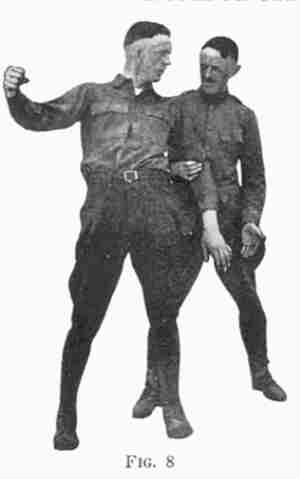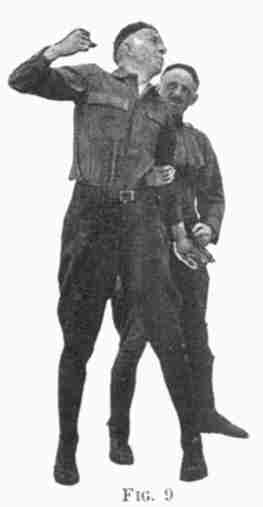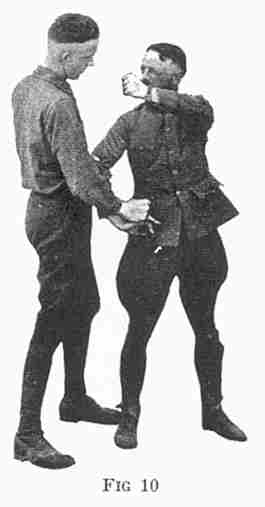
- •Stahara publishing company
- •Lesson 1.
- •Instead of trying to free your wrists by the strength of your arms, you force them out by the strength of the abdomen and the weight of the body.
- •Instead of memorizing this as an abstract principle, visualize it in the concrete instance of the simple trick exemplified on the preceding page.
- •Ichi II-gatashi.
- •Lesson 2.
- •In fact, in a five minutes bout in jujitsu each will have made the other quit several times and they will always keep smiling.
- •Lesson 3.
- •Lesson 4.
- •Lesson 5.
- •Lesson 7.
- •In short, they wanted to train, not only the muscular endurance of the soldier, but his morale, or fighting spirit.
- •Lesson 8.
- •Lesson 9.
- •Lesson 10.
- •Lesson 11.
- •In practice put strength into the blow but stop it a few inches from his neck. With this blow it is an easy matter to knock a man out.
- •Lesson 12.
- •Lesson 13.
- •Summary
- •Lesson 14.
- •Seized from behind -- Fig. 82
- •Lesson 15.
- •Lesson 16.
- •In practice exert only sufficient pressure to force opponent to give the signal of defeat.
- •Lesson 19.
- •Lesson 20.
- •Lesson 21.
- •Lesson 22.
- •Lesson 23.
- •Lesson 24.
- •In teaching men who were going to the war, all the training was directed towards making them kick or hit a vital spot rather than try for a hold.
- •It seems that the burglar threatened him by brandishing a two-handed, razor-edged Japanese sword over his head, and demanded his money.
- •Lesson 25.
- •Lesson 26.
- •Lesson 27.
- •Lesson 28.
- •Lesson 29.
- •Lesson 30.
- •Lesson 31.
- •In practice, do this so slowly that there is no danger of injuring your opponent's elbow. He will stand still and let you experiment, and you must allow him the same privilege.
- •Lesson 32.
- •Lesson 33.
- •Lesson 34.
- •Lesson 35.
- •Lesson 36.
- •In practice do it slowly and release him the instant he quits.
- •Lesson 37.
- •Lesson 38.
- •Lesson 39.
- •Verbum sap: a word to the wise is sufficient
- •Lesson 42.
- •Lesson 43.
- •Lesson 44.
- •Lesson 47.
- •Lesson 48.
- •It is not recommended as a practical fighting trick, as it leaves you open to a kick just before it is secured.
- •Lesson 51.
- •Lesson 52.
- •Lesson 53.
- •If you start too roughly at first with one another, you will never continue your practice to the point of proficiency. Advanced practice in throwing man from behind
- •Lesson 54.
- •Lesson 55.
- •Lesson 56.
- •If the escape be executed before Assailant gets his full pressure on your neck, it is easy to get away.
- •Lesson 57.
- •If you do it gently, not only is there no danger, but no discomfort.
- •Lesson 58.
- •Lesson 59.
- •If you are on patrol duty and see an enemy ahead of you whom you must "get" without letting him give the alarm, steal up silently and get him unawares.
- •Lesson 60.
- •Lesson 62.
- •In practice, be gentle. In actual attack knock him out, or at least render him speechless, by a sharp blow on the windpipe with the wrist.
- •The scope of this course
- •"It isn’t whether we win or lose, but how we play the game."
In fact, in a five minutes bout in jujitsu each will have made the other quit several times and they will always keep smiling.
THE LITTLE FINGER "COME-ALONG"
The order given was: "On the command 'Forward MARCH' the captured men will try to escape.
Lesson 3.
This lesson gives further instruction in how to take bone-breaking grips on the opponent and control him without any danger of breaking his bones.
The Little Finger "Come-along."
Unbalance opponent the moment you grasp him, and keep him off balance until you have secured the grip.
The fascinating game of -- "Tickle my nose, if you can."
Growth of self-confidence.
The Major Operation.
The Minor Operation.
The more haste the less speed.
T
 he
escape from the Little Finger "Come-along."
he
escape from the Little Finger "Come-along."
LITTLE FINGER "COME-ALONG"
Standing on opponent's left side, seize him with your right hand just above his left elbow with your thumb round the other side of his arm.
Step quickly behind him, unbalancing him towards you, thus preventing him striking you with his other hand.
Slip your left hand, palm up, below his left hand, which is hanging palm down.
Grasp his fourth and fifth fingers. Hold his wrist and his elbow pressed tightly against your Stahara.
Keep your legs well apart and be well balanced.
Bend his wrist at right-angles to his forearm, and his fingers at right angles to his wrist.
Bring him onto his toes, off balance, by upward pressure on his fingers and march him around the room.
Practise
this hold with both hands.
U NBALANCE
OPPONENT THE MOMENT YOU GRASP HIM AND KEEP HIM OFF BALANCE UNTIL YOU
HAVE SECURED THE GRIP
NBALANCE
OPPONENT THE MOMENT YOU GRASP HIM AND KEEP HIM OFF BALANCE UNTIL YOU
HAVE SECURED THE GRIP
Grasp opponent with right hand only as in fig. 8. Tell him to tickle your nose, and as he attempts to swing his right hand to your face, pull his left elbow towards you, thus unbalancing him to his left back corner.
Notice in fig. 8 how, by unbalancing the opponent in this manner the threatening movement of his right hand has been checked. Try this experiment a number of times. Neither of you should move your feet at first. THE FASCINATING GAME OF -- "TICKLE MY NOSE, IF YOU CAN"
You should play the game of "Tickle my nose" with each trick to make sure that you have mastered it. If opponent cannot tickle your nose, he would be unable to strike you.
You can thus demonstrate to your own satisfaction that you have mastered each trick.
The moment he withdraws his hand, relax the pressure. When he again attempts to raise it, apply fresh pressure. Do this with the minimum movement and the minimum pain and you will be able to make him quit whenever you wish without hurting him. GROWTH OF SELF-CONFIDENCE
After holding a man helpless with the Little Finger grip you will experience a sudden rise in your morale. This is the psychological result of the discovery of physical powers you did not know you possessed.
This is merely a foretaste of greater powers yet to come, and a still greater growth of confidence in yourself, which is a valuable factor in fighting the battle of life. THE MAJOR OPERATION
Take the position of fig. 9, relax the pressure of your grip until he feels no pain.
This can be done with a hardly perceptible movement. Anyone watching your hand and your opponent's hand would see no change of position.
After a little practice you will be able to grasp opponent and instantly secure the grip up to the point where you have "got" him but without his feeling any pain, as yet. THE MINOR OPERATION
Tell opponent to raise his right hand slowly and attempt to tickle your nose.
As he raises it, slowly apply the pressure and you will check his attempted move.
Do not apply more pressure than is necessary to check him. MASTERING THE COURSE WITHOUT AN INSTRUCTOR
Two absolutely inexperienced men or women can easily master the entire course without a teacher if they will observe the following rule:
Alternately take the role of victim and unresistingly allow each trick to be practised on you, and in turn practise it on your partner until you have mastered both the Major and Minor Operations.
This will safeguard you against injuries and will reduce the time necessary for each trick.
In more advanced practice you may execute the Major operation with full speed and strength but the Minor operation is always performed gently and with the minimum of movement.
It may be suggested that you go thru the entire course once before you try any practise for speed.
THE MORE HASTE THE LESS SPEED
In jujitsu demonstrations I have frequently allowed a man to attack my throat with his thumbs on my windpipe and to do his utmost to choke me and have instantly secured a lock on his arm and held him powerless, but without hurting him. Frequently some enthusiastic member of the audience will try a similar grip on the arm of a friend but will nearly break his arm, with the result that his friend will absolutely refuse to practise any more.
Now, if these young men had waited until they were shown what part of the trick to take swiftly and what part to do slowly, they would have been able to practise with a great deal of profit and pleasure. They would have been able to continue that practice until they were really efficient without any danger to their limbs.
So you must analyze every trick into its two operations -- Major and Minor, and while you take the first one quickly, take the second one slowly.
Altho you divide them mentally there will be no pause between them; they will both appear to be one swift movement.
You
must try each trick very gently to find out where the Major o peration
ends and the Minor operation begins.
peration
ends and the Minor operation begins.
 THE ESCAPE FROM LITTLE FINGER "COME-ALONG"
THE ESCAPE FROM LITTLE FINGER "COME-ALONG"
If assailant omits to imprison your forearm tightly between his hands and his Stahara and merely holds you with the strength of his hands --
Swing right shoulder and elbow upwards, making the effort from the Stahara, dropping our left shoulder and if necessary striking him in pit of stomach with left fist.
This method of escape evades the pain of the grip. If he holds you tightly against his Stahara and keeps the pressure on your fingers there is no escape.
In actual combat it might be necessary to break an enemy's finger, but this ability to "treat 'em rough" is best acquired by careful practice in which you avoid injuring one another.
